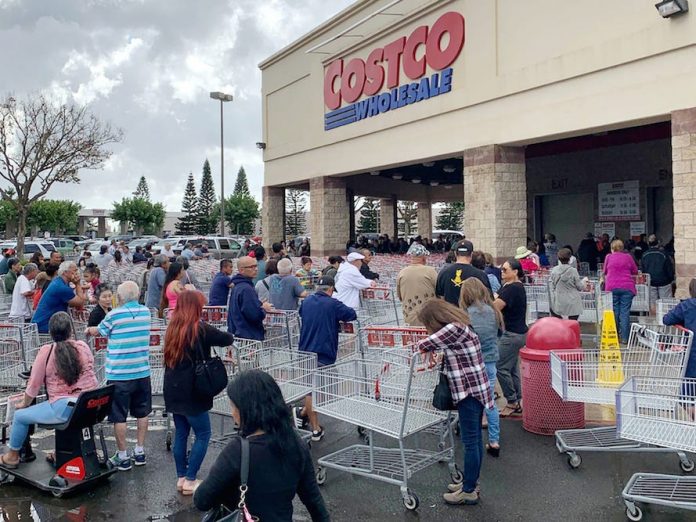As a prepper or survivalist, we’re all typically proud to be prepared for SHTF situations. We usually have a good quantity of non-perishable foods stored, as well as options for hunting, fishing, trapping and gardening. Not everyone’s prepared for a worst-case scenario. Despite our best efforts, many of us will be forced to join the masses and go to the grocery store for days or weeks to come. If that happens, this is your guide to surviving the ordeal and getting good nutrition.
How to Avoid the Grocery Store
Before we dive into the grocery store’s chaos, I will highlight how much more efficient it can be to avoid the shop. If you have the means to stockpile dry and canned goods in advance, please do so. My family always has woods for hunting, a fishing pond, a vegetable garden, fruit trees for peaches and apples, and even a trap line. We have vineyards, wild edibles, mulberry trees, blackberry bushes. We can make vegetables and meat, make jerky, keep hard tack, make pemmican, and keep handmade granola. If we’d lose the power grid, we’d have food for months if not years. This is the ideal setup to avoid SHTF grocery store.
What to Anticipate at the Store
Ever been shopping Black Friday? Imagine that, but add that everyone is fighting for their lives. Yes, it’ll be crazy. Initially, people will assume power will be restored in a few days, so perishable versus non-perishable won’t be a huge factor. Milk, eggs, bread, butter, meat, pre-made meals will go first. Such aisles can either be picked up or will be a war zone, so it’s best to avoid them. Batteries, food, cigarettes, and toilet paper always go easily. After 72 hours, people will start realizing this problem could be long-term. At this point, the focus will be on canned goods and dried goods. In order to come home with anything of value, you need a strategy going into the store.
Related: The Biggest Stockpiling Mistakes
Phase 1
When you first walk through the shop, you should try to select the high-value things other people may overlook. We ‘re assuming you’re shopping on day one of panic, so you’ll have some opportunity. Focus your first sweep on non-perishable products. This includes rice, pasta, beans, powdered milk, juice, powdered eggs, jerky, boxed meals, canned goods, pickled items, dried fruits, nuts, popcorn, cereal, crackers, or anything else not to be cooled or frozen. Look for any toiletries that may be overlooked. Everybody will go for toilet paper, but things like deodorant, toothpaste, soap, shampoo, razors, and shaving cream will make life much simpler for you and your family. Many people will think short term like they might think during a major snowstorm. They can’t understand the disaster could last weeks or months. Utilize their naivety.
Phase 2
Upon finding as many of the overlooked high-value items as you can, you can move on to things that almost everyone forgets. At this stage, you will be in largely deprived aisles. Hit the aisle for rice, oats, sugar, butter, spices. Such ingredients will render all sorts of different foods. Go after disposable items like cups, paper plates, silverware, and towels. With limited water for cleaning dishes, these items can really help. Pick up cleaning supplies for the kitchen, bathroom, and laundry. Get aspirin, bandages, Benadryl, antacid, prescriptions, rubbing alcohol, iodine, chap stick, and petroleum jelly. Raid the vitamin aisle for multivitamins, protein drinks, energy bars, and supplements. Take some chocolate bars for occasional treat and as a barter with others.
It may sound strange, but get some wet, dry dog food as a last resort for nutrition. If your other food runs out, it’s certainly better than nothing, and you can also use it for trapping. A random aisle may have charcoal, flashlights, candles, cordage, superglue, and air freshener. Even books or magazines are good for keeping everyone sane during a disaster. All these are items normally left on the shelf when people panic over survival. Go after these items before leaving. You don’t want more than one ride to this mad place.
Related: Why Are Food Prices Increasing One Month into the Corona Virus Pandemic?
General Caution
When you reach the shop, be realistic about what you are going to face. Struggles over a gallon of milk. Citizens will be misled. Someone may open fire to clear an aisle. It’s a dangerous scenario. As you move through the store, be the grey man. Blend in and don’t attract attention. Move fast, but don’t run. If there’s conflict in one store area, move to another. If possible, avoid paying with cash so nobody would be tempted to try to rob you. Bring a way to defend yourself, but don’t pull it out unless you have another choice. Working through this store will be like escaping a riot. With a little patience and luck, you’ll get the things you need and get out fine.
While none of us want to think about being forced into this scenario, some people will inevitably. Organization and preparation are key. Don’t run into the store, go nuts like anybody else. Be methodical about your target products. When you go for the things others overlook, you’ll get more of what you need, there’s little risk of conflict. Follow this strategy, and store your pantry to last through your SHTF scenario.





















